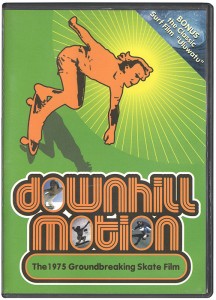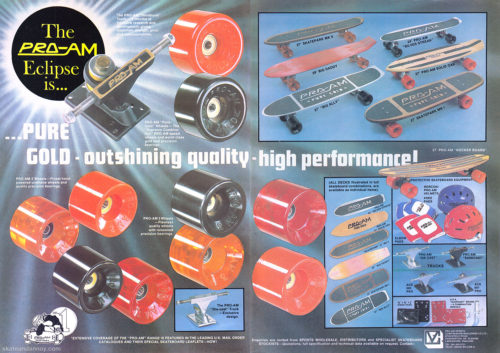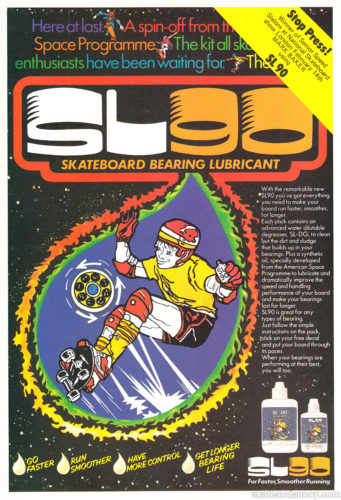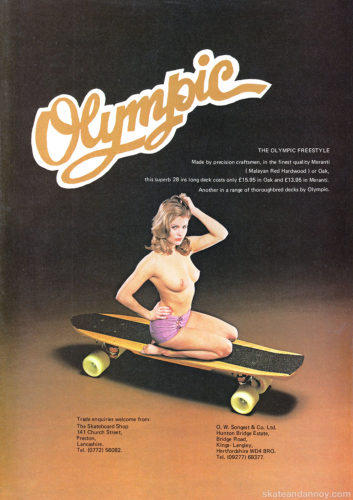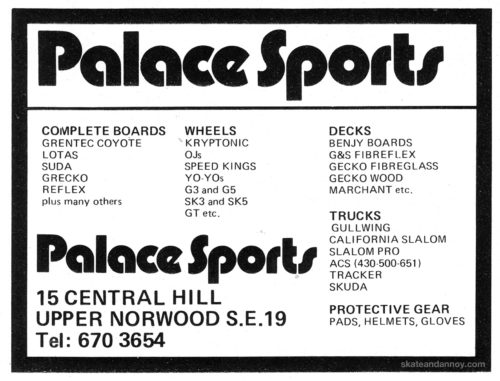Downhill Motion
Downhill Motion
Greg Weaver and Spyder Wills
There was a time when skateboards had steel or clay wheels. Both were hard and slippery. Then the urethane wheel was developed and first marketed to skateboarders by a guy named Frank Nasworthy as Cadillac Wheels. The new wheels provided a smooth ride with enough traction to allow skateboarders to make radical changes of direction without slipping out.
The first Cadillac Wheels ads in Surfer magazine featured a barefoot blond kid doing a low turn that looked a lot like a bottom turn you might do on a surfboard. The kid’s name was Gregg Weaver and he made it look like skateboarding could be a true simulation of surfing – without the ocean. Millions of landlocked kids could ride like surfers did. The kid from the Cadillac ad appeared on the cover of the first issue of the resurrected Skateboarder Magazine half way up the wall of an empty swimming pool. He was the Cadillac Kid, the most famous skateboarder around. Attention shifted away from him as other skaters did gnarlier tricks, went faster and higher and found more amazing terrain but a different Greg Weaver and Spyder Wills were there the whole time, skating and documenting the early days of modern skateboarding.
The locations will be familiar to anyone who devoured the skateboarding features in Surfer magazine and that first year of Skateboarder. The banks, flood control structures, and pools were all in “the mag” every month as were the hills of the planned but at that point unbuilt housing developments of La Costa, California. A lot of the photos in that first year of Skateboarder seem to have been shot over the shoulder of the Downhill Motion cameramen.
Downhill Motion is a history lesson for people who weren’t there. This is how it started: skaters riding down the sidewalk, doing freestyle tricks, cruising hills and racing, getting towed down the street by the dog, hanging out at the beach, skating barefoot. The pool sessions are just like I remember. A dozen skaters in the shallow end mostly just getting over the light or hitting tile – a few just making it to the coping. Working the pool and hitting several walls in a row was so novel it had a name: “forevers” Downhill Motion includes early footage of skaters carving the Mt. Baldy Pipeline – no graffiti – as well as footage of the Fruit Bowl and the Signal Hill downhill race.
Filming was done between 1974 and 1977. It was screened occasionally in theaters with surfing films and was first shown in 1977. Downhill Motion was made before home video. The popularity of Dogtown and Z-Boys rekindled interest in skateboarding for a lot of old skaters and the reappearance of this film on DVD provides a further look into the roots of skateboarding. Downhill Motion features funky cowboy narration by Spyder Wills, (“These guys don’t have tans, they live underground like moles. They’ve got this place wired though.”) and original music – lots of choice stuff in there. Prominent skaters of the time are called out but there is none of the self-congratulation or personality cultism of Dogtown and Z-Boys. Downhill Motion is about skateboarding more than lifestyle.
One particularly lyrical scene is a lengthy shot of Weaver carving a hill, walking the board, turning and spinning – viewed through heat waves so the viewer can’t even make out the skateboard. It is a reminder how cool just cruising down a hill on a skateboard can be. Nothing gnarly or extreme, no danger, just flow and style. What a contrast to modern filming of long series of quick cuts of single tricks. This film could remind you how to have fun riding your skateboard.
Extra Features: The DVD also includes the surfing film Uluwatu which follows pro surfers Gerry Lopez and Rory Russel to Indonesia. More Spyder Wills narration and more soul rides. Nothing mind-blowing except how relaxed these guys seem. Worth checking out. Presented with voiceover in the same classic style as Downhill Motion.
Runing Time: Downhill Motion : 50 minutes. Uluwatu : 25 minutes.
Reviewer: Mark Conahan

